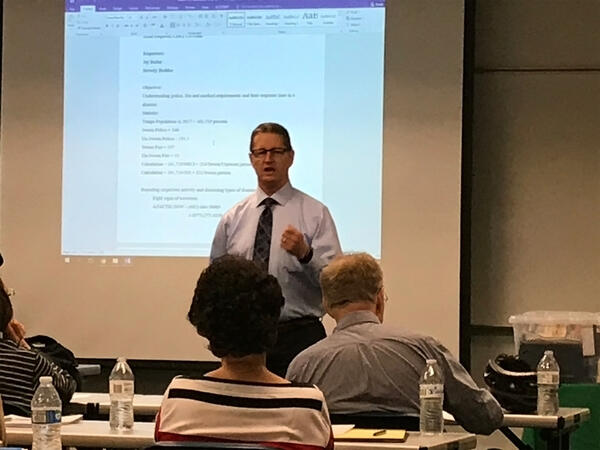
Event report
March 2018 - Emergency Preparedness Seminar
Dawn Hermanson and Ernie Paquette, co-leaders of the Tempe Community Emergency Response Team (CERT) program, and Brent Olsen, Manager of the City of Scottsdale’s Office of Emergency Preparedness, shared about the CERT program and how it educates volunteers about disaster preparedness for the hazards that may impact their area and trains them in basic disaster response skills. Seminar attendees were encouraged to attend the next CERT training program, offered by the City of Scottsdale in Spring 2019. Interested folks can sign up through the www.scottsdaleaz.gov/emergency website. In lieu of the training program, the CERT training manual can be reviewed at the FEMA website.
The following information, taken directly from the “Ready Maricopa County” brochure on preparing for emergencies best sums up the information shared at this seminar.
Being prepared for any emergency – whether a house fire, power outage, flood, or terrorist attack – is as easy as 1, 2, 3. Step 1, take the time to work out a disaster plan. Step 2, gather supplies to keep in your home. Step 3, put together a Go Bag. A few simple steps can go a long way should disaster strike.
Step 1, Have a HOUSEHOLD DISASTER PLAN. Develop a disaster plan with your family members to prepare for what to do, how to find each other, and how to communicate in an emergency. Record plan details on a small reference card.
- Decide where your family will reunite after a disaster. Identify two places to meet: one right outside your home and another outside your neighborhood, such as a library, community center, or place of worship.
- Know and practice all possible exit routes from your home and neighborhood.
- Designate an out-of-state friend or relative that family members can call if separated during a disaster. This out-of-state contact can help you communicate with others.
- Account for everybody’s needs, especially seniors, children, people with disabilities, and non-English speakers.
- Ensure family members have a copy of your family disaster plan and emergency contact information to keep in their wallets and backpacks.
Step 2, Have an EMERGENCY SUPPLY KIT. Keep enough supplies in your home to survive on your own for up to 10 days. If possible, keep these materials in an easily accessible, separate container or special cupboard. You should indicate to your family members that these supplies are for emergencies only. Check expiration dates of food and update your kits EVERY THREE MONTHS.
- One gallon of drinking water per person per day.
- Non-perishable, ready-to-eat canned foods and manual can opener.
- First-aid kit.
- Flashlight and extra batteries.
- Battery-operated AM/FM radio and extra batteries.
- Whistle.
- Iodine tablets or one quart of unscented bleach (for disinfecting water ONLY if directed to do so by health officials) and eyedropper (for adding bleach to water).
- Personal hygiene items: soap, feminine products, toothbrush and toothpaste, etc.
- Phone that does not rely on electricity.
- Child care supplies or other special care items.
- Tools.
Step 3, Have a GO BAG. Every family member should pack a Go Bag – a collection of items you may need in the event of an evacuation. A Go Bag should be packed in a sturdy, easy-to-carry container such as a backpack or suitcase on wheels. A Go Bag should be easily accessible if you have to leave your home in a hurry. Make sure it is ready to go at all times of the year.
- Copies of your important documents in a waterproof and portable container (insurance cards, photo IDs, proof of address, copies of prescriptions, etc.).
- Extra set of car and house keys.
- Credit and ATM cards and cash, especially in small denominations. We recommend you keep at least $50-$100 on hand.
- Bottled water and non-perishable food such as energy or granola bars.
- Flashlight and extra batteries.
- Battery-operated AM/FM radio and extra batteries.
- Medications and other essential personal items. Be sure to refill medications before they expire. Keep a list of the medications each member of your family takes, why they take them, and their dosages.
- First-aid kit including bandages and antibiotic ointments.
- Change of clothes; sturdy, comfortable shoes; lightweight rain gear; coat and blanket.
- Contact and meeting place information for your family, and a small regional map.
- Child care supplies (diapers, wipes, food, formula) or other special care items.
During the discussion about a communication plan, the speakers noted additional information of importance.
- Home telephone landline. In an emergency, use your landline to call 911 as the 911 operators can easily identify your location. The telephone instrument should plug directly into the telephone wall outlet and not rely on electricity since a power outage would render that unit useless.
- Cell phones. In a disaster situation, the text option may work faster than the audio options. Register your cell phones with the Community Emergency Notification System. This system is designed to rapidly notify an affected area of an emergency by sending a recorded message through the telephone system.
- Alternative communication devices would include ham radios (must have a license to use, there are 3 levels of licensure) and satellite phones.
- While it may take a little work to gather the items needed for a disaster kit or Go Bag, there is nothing like the peace of mind it can bring.
Story and Pictures by Bev Buddee

Brent Olsen - Manager of the City of Scottsdale's Office of Emergency Preparedness

Dawn Hermanson - Tempe Community Emergency Response Team